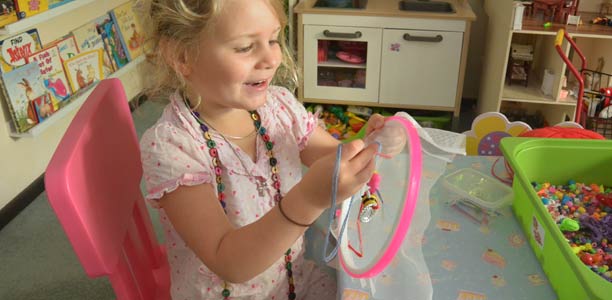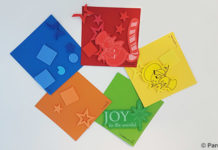Age
3-10 years
Duration of activity
20-30 minutes
Materials/equipment
- Embroidery ring/frame
- White fly net from a haberdashery shop or similar netting
- Darning needles (blunt plastic needles)
- Wool (younger children) or embroidery thread (older children) preferably in assorted colours
- Adornments like beads and sequins (optional).
Cost
Netting is available from Haberdashery stores for about $5 a metre. One metre is more than enough to keep your child busy embroidering for many days. If you don’t already have them at home you can also find embroidery rings and darning needles at the haberdashery store for about $8 and $3 respectively. Your child will only need short lengths of wool for embroidering so you can use leftovers instead of buying wool.
Preparation
 Cut a piece of netting and fix it tautly in the embroidery ring. You’ll need a piece that’s slightly bigger than the ring so that all sides overhang and it can be clipped in the ring fastener. Older children should be able to do the preparations themselves.
Cut a piece of netting and fix it tautly in the embroidery ring. You’ll need a piece that’s slightly bigger than the ring so that all sides overhang and it can be clipped in the ring fastener. Older children should be able to do the preparations themselves.
What to do
- Show your child the embroidery ring and netting and explain to them that today they will learn to sew using them. Tell them that they will sew using different coloured wool to make a beautiful picture or pattern.
- If you have never done this activity with your child it might be good to demonstrate to them how to sew by pushing the needle through one hole and then another to make a stitch before they start. You might also like to show them some finished examples so they can see what’s possible and motivate themselves to persist and overcome the challenges they’ll face doing this activity.
- Show them the needle and the coloured wool and ask your child to choose which colour they would like to begin sewing with.
- When they have chosen a colour ask them to thread the needle and knot the end so that it doesn’t pull through the fly net when they start to sew (older children) or thread and knot it for them (preschoolers).
- Give them the threaded needle and ask them to start sewing their picture or pattern. It doesn’t really matter what they sew- encourage them to be creative. Young children who are doing this activity for the first time will need a bit of help, for example you may need to sit with them and give them instructions about how to pull the needle and where to place it next to make a stitch. Older children who are already familiar with sewing will be able to do this on their own.
- If you have adornments like beads or sequins your child may like to sew them onto the fly net by passing the threaded needle through the hole in the bead while stitching.
- When your child has finished their first length of wool, or whenever they want to, let them choose a second colour to sew with. Help them to thread the needle with that colour if needed.
- Talk to your child as they sew about the picture or pattern they are making and ask questions, for example about the colour of the wool or the size, shape and position of the things they sew.
Tips
 This is a great activity for your children to do while you’re sewing. You’ll already have your sewing things handy and your child will probably enjoy sewing just like mum or dad.
This is a great activity for your children to do while you’re sewing. You’ll already have your sewing things handy and your child will probably enjoy sewing just like mum or dad.- Challenge older children by drawing pictures or patterns on paper and asking them to try and make the same pattern with their sewing.
- Frame your child’s creation, or cut it out and stick it on cardboard to make a card to give their grandparents or another special somebody, or just to keep as a momento of their early sewing lessons.
- Use a long piece of fly net and place a different section in the ring for your child to embroider on several different days. You can then help your child turn their embroidery into a cape, or sew ribbon to the top edges and tie it around their neck or waist.
Safety
- Use only blunt-tipped darning needles for young children. Sharp sewing needles can be dangerous.
Educational outcomes
Fine motor skills
This learning to sew activity is perfect for helping young child develop their fine motor skills, that is, the ability to manipulate objects using their fingers with dexterity and precision. Holding the needle in their fingers and controlling its movement to place it through a hole in the fly net is a precise movement which requires significant control. As your child makes these movements (or tries to make them) they’ll be further strengthening their finger muscles and learning to coordinate the movements they make with their fingers, with what their eyes see.
 What your child will be able to do and what they’ll need your help with will depend on their age and ability. Three year olds will usually be able to thread large beads onto the wool as they go but will probably need a hand threading the needle and knotting the wool at the end. By four or five years of age children will have developed more precise movements and the ability to thread smaller beads on the wool. They may also be ready to start threading their own needle and knotting the end by themselves. Older children should be able to complete this activity by themselves with a bit of encouragement.
What your child will be able to do and what they’ll need your help with will depend on their age and ability. Three year olds will usually be able to thread large beads onto the wool as they go but will probably need a hand threading the needle and knotting the wool at the end. By four or five years of age children will have developed more precise movements and the ability to thread smaller beads on the wool. They may also be ready to start threading their own needle and knotting the end by themselves. Older children should be able to complete this activity by themselves with a bit of encouragement.
Creativity
This sewing activity requires your child to use their imagination and creativity when deciding what to sew and where. It takes quite a bit of time and lots of patience to sew something by hand, and completing this sewing activity will give your child a sense of the wonderful things they can do, if they sit down, use their imagination and persist. As they practice and develop their creative skills and their ability to concentrate for longer periods of time, they’ll produce increasingly complex designs- make sure you give them the time and support they need to overcome the challenges that will almost certainly present themselves along the way.
Encourage your child to experiment with different techniques as they sew, for example threading different numbers of beads to each stitch or finding other objects to sew on. Encourage them to talk about what they sew, as when they do they’ll also be using their creativity to describe their sewing, for example when they tell you that the blue square at the top is the sun and the blob at the bottom is a person.
Maths
Sewing provides a range of mathematical learning opportunities as well. Pre-schoolers will enjoy talking about the shape and colour of the objects they sew. They’ll develop their mathematical vocabulary, for example when they use words to describe size and colour and the location of various components of their design (e.g. tell you that the person is down the bottom and the square they’ve sew on the right hand side is a window).
Your child probably won’t pull out a ruler to measure their creation (although that’s a great lesson in measurement if they want to!) children should be able to measure accurately with a ruler from about seven or eight years of age. However they’ll still have to think about size as they sew. For example, they’ll need to think about how big they make their stitches and how far apart they place the different patterns or components of their sewing design on the canvas. They may enjoy comparing the size of their stitches or designs. Six and seven year olds will be at the point where they measure by comparing the size of objects (e.g. comparing the length of a stitch to the width or a pencil or other object).
Communication and social skills
Learning to sew is a great opportunity for your child to practice communicating, for example they’ll need to listen and follow instructions as they do this activity. In addition as they talk with you through this activity, for example when they ask a question or tell you about what they’re doing, your child will enhance their understanding of the conventions of conversation. They’ll have an opportunity to practice speaking and using new words and phrases, or pronouncing new words with unfamiliar sounds (e.g. embroidery). They’ll also gain confidence knowing that they have the ability to learn new and challenging things like how to sew.
It’s also a great opportunity to talk to your child about the historical importance of sewing, which may not be apparent to kids born in the 21st century who find their clothes on shop hangers and may never have seen someone making an article of clothing by hand. Your child will begin to better understand the world around them and how it has changed over time, which also helps them understand their place in the world.
References
- Virginia Early Childhood Development Alignment Program. Milestones of child development- A guide to young children’s learning and development from birth to kindergarten. 2009. (cited 14 December 2014). Available from: (URL Link)
- Brinkley M, What is gained through learning to sew? 2013. (cited 14 December 2014). Available from: (URL Link)
- Australian Curriculum Reporting and Assessment Authority. Mathematics Curriculum. 2014 (cited 14 December 2014). Available from: (URL Link)
- Andrews. General Categories of Fine Motor Development. Michigan State University Extension. UNDATED. (cited 28 March 2014). Available from: (URL Link)



 (7 votes, average: 4.43 out of 5)
(7 votes, average: 4.43 out of 5) 






